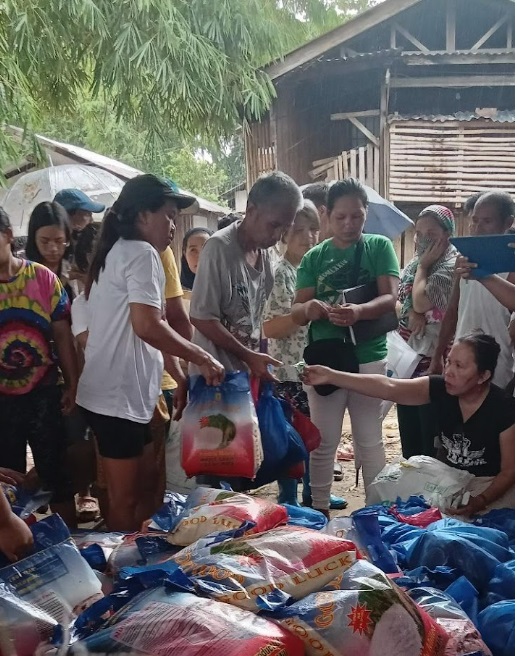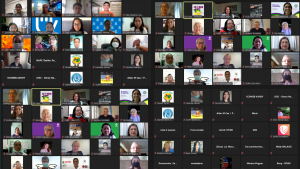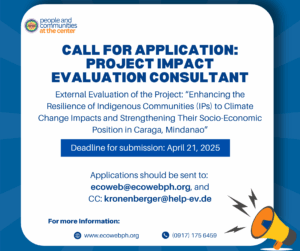RIVERSIDE, Mahayahay, Iligan City—Weighed down from carrying 2 sacks of 5-kilo rice and grocery bags, their sweat mingled with raindrops trickling on their brows, a smiling middle-aged mother took a short breather while a father of four shouted instructions to the queue of people as a 23-year old impromptu purok leader took videos and photos of the communal activity.
The heavy downpour brought about by a darkened sky over Iligan City on that Thursday (Nov. 16, 2023) afternoon failed to dampen the spirits of the residents of Zone 1 and Zone 2 of Riverside, Mahayahay as they happily waited their turn to be called and lined up to receive the food items/relief goods.
The relief goods were procured by the women’s organizations through the microgrants from the Ecosystems Work the Essential Benefits (EcoWEB), Inc. The women’s organizations also conducted the distribution process to the affected families.
“These relief goods will help to relieve us from the worst experience we had gone through,” a member of the LGBTQIA++, who refused to be named, said. She also expressed happiness for being able to volunteer her help to her community.
All listed flood-affected families, about 405 families (198 in Zone 1 and 207 in Zone 2), each received 10 kilos of rice (2 sacks of 5 kilos each), several packets of noodles and pancit canton, several canned goods (sardinas and beef loaf) and other necessities such as packets of bath and laundry soap, and sachets of instant coffee.

A victim of the November 7 freak flashflood in Zone 2, Riverside, Mahayahay, Iligan City receives from the women’s association the relief goods for his family on November 16, 2023. (Photo by Bong D. Fabe)
The women’s organizations of the two zones wrote proposals for a microgrant to the EcoWEB, which the NGO granted, through the generosity of its current funding agencies Legatum Limited Foundation and Vitol Foundation. Zone 1 was given a microgrant of Php195,000 while Zone 2, Php253,000 or a total of Php448,000.
Nanay Erlinda Flores Aguas, 75, (in red shirt, left) explains to the community in Zone 1, Riverside, Mahayahay the processes and protocols the zone’s women’s association followed in coming up with the list of victims, the proposal they submitted to EcoWEB, the procurement, marketing and distribution to ensure transparency and accountability. (Photo by Bong D. Fabe)
Appreciative Inquiry:
The flashflood that inundated some parts of the city at nightfall on November 7, particularly Zone 1 and Zone 2 of Riverside, Mahayahay, damaged several properties, said Gail Lovely P. Lao, president of the Zone 2 Riverside Women’s Association.
Knowing of the hardships faced by the flood-affected communities, the EcoWEB conducted an appreciative inquiry at Zones 1 and 2, Riverside on November 10, three days after the flood. EcoWEB staff, together with some leaders of the Iligan City Council of Women (ICCW), conducted interviews and consultation with the affected communities.
But more than consultations, they also empowered the communities by helping them help themselves through organizing the women in their communities to lead their recovery efforts.
Leaders of the women’s association of each zone then conducted a house-to-house visitation in their respective communities to talk with the flood-affected and know firsthand their most immediate and priority needs. After identifying each household’s needs, the women’s associations then submitted a proposal for a microgrant to EcoWEB, itemizing the number of affected families listed as well as the food items they need.
“EcoWEB, ICCW and other volunteers/leaders taught us the process in interviewing people to get their priority needs so we can respond appropriately. We did not discriminate anyone in our house-to-house survey,” said Gail Lovely.
The respective proposals for a microgrant from the two women’s association were submitted to EcoWEB on November 13. Two days later, or on November 15, the NGO released to them their microgrants. With money on hand, they immediately procured all the food items and transported them to the area with the help of the men of each zone who volunteered to help the women. Volunteers from the community then helped repacked the food items for distribution.
Maryann Togonon, one of the victims of the freak flashflood that inundated Zone 1 and Zone 2 of Riverside, Mahayahay on November 7, 2023, smiles after receiving the relief goods distributed to flood-affected families by the women’s association. (Photo by Bong D. Fabe)

A member of the community volunteers in carrying the sacks of rice for distribution to the victims of the freak flashflood in Zone 2, Riverside, Mahayahay, Iligan City. (Photo by Bong D. Fabe)
Transparency and Accountability:
“It was our first time to hold that kind of amount,” said 75-year-old Erlinda Flores Agua, president of Zone 1 Riverside Women’s Association. Analou D. Apas, 36, the social manager of the Zone 2 Riverside Women’s Association, agreed. Both laughed out loud when they narrated the experience of feeling excited but at the same time feeling apprehensive and nervous.
But EcoWEB staff and men volunteers who accompanied the women leaders to the bank to cash the check assured them that they are well protected from the bad elements of society.
To ensure transparency and accountability, the women leaders made sure that every item they purchased were clearly identified in their receipts. They also presented their liquidation to their respective communities. Aside from that, they also took photos of the items purchased, video their repacking process and then posted these on their respective Facebook accounts.
“Transparent gyud mi. Dili man among kwarta; para man kato sa mga nabahaan. So dapat makabalo jud sila pila ang grant gikan sa EcoWEB ug pila ang kantidad sa tanan namong gipamalit. Para walay yawyaw ug away ba (We are transparent. It was not our money; it was for the flood victims. So it is important that they know how much was the grant from EcoWEB and how much we spent to purchase the items. This is to avoid snide remarks/comments and quarrels),” said Nanay Erlinda, as she is respectfully called in her community.
The relief goods were also placed in a very conspicuous are for everyone in the community to see.
Efficient and Effective:
During the distribution of relief goods on November 16, several members of the community noticed that it was conducted very differently from the usual government-initiated distribution.
While there were some men and LGBTOIA++ who volunteered their services to help in the distribution, especially in guarding the mound of relief goods, it was all the initiative of the two women’s association in Riverside, Mahayahay, with some coaching from NGO leaders.
One man in Zone 1, a Maranao, who did not give his name for this report, remarked that it was the first time he saw a distribution of relief goods done efficiently and effectively.
“Walay pili. Tanan biktima giadtoan sa ilang balay sa mga babaye ug tanan pamilya gilista, bisan mga renters lang. Ug tanan nga nalista, gihatagan og relief goods (No one was discriminated against. The women went to the houses of all victims and all families were listed, including those who were just renting. And everyone who was listed was given relief goods),” he said.
Gail Lovely, a young mother as she is at 23 years old, admitted that the process was very tiring. “But it was worth it,” she beamed.
“Ang community-led response kapoy kaayo kay wala man mi na-train ani. Pero kay kami man gyud ang naka experience ug nakabalo sa unsa gyud ang panginahanglanon, mas better gyud ang among pamaagi kumpara sa gobyerno (Community-led response is very tedious especially since we are not trained to do this. But because we ourselves experience the calamity and we know what the community’s priority needs, our process it way better than the government’s),” she said.
Several flood victims in both Zone 1 and Zone 2 disclosed that not one person from the relief agency of the government such as the Department of Social Welfare and Development (DSWD) came to their communities to see for themselves the extent of the damage by the flood and talk with the affected to know their needs.
“Lahi ra gyud ang among pamaagi. Ang gobyerno naa nay andam nga relief goods ug ipanghatag na lang sa mga moadto ug magpalista. Unsaon man kung ang sulod sa ilang gipanghatag nga relief goods wala kinahanglana sa biktima nga nakadawat niini? Sayang lang! (Our way is really different. The government always has relief goods on the ready and they just distribute these to the victims who come to them to be listed. However, what if some items of the relief goods they gave are not what the victims needed? It will just be wasted!),” said 49-year-old Henry Macapil, vice purok leader of Zone 1.
He said it is really important for the victims to voice out what they really need to avoid complaints after receiving the relief goods.
“Walay reklamo diri sa amoa kay nakuha man sa women’s association unsa ang gikinahanglan. Ila man gyud gitagsa-tagsa og interview kada pamilya (There were no complaints here because the women’s association know what the victims needed because they interviewed each family),” he added.
Why SCLR?
Through the Recovery and Building Resilience through Survivor and Community-Led Response (SCLR) Program of the EcoWEB, communities devastated by calamities are capacitated and accompanied to help themselves rise up and recover. EcoWEB promotes the SCLR approach in responding to crisis and disasters in an effort to link humanitarian, development and peace initiatives.
The SCLR approach is a humanitarian and crisis response that aims at enabling communities affected by disasters to help themselves survive and rise with dignity, uphold their rights and harness their capacity to address their emergency needs as well as the root causes of their vulnerability to crisis and disasters.
SCLR approach promotes the provision of multi-purpose cash grants for the most vulnerable and marginalized families and communities. SCLR approach ensures gender-responsive, inclusive, culture-sensitive, empowering, do-no-harm and peace-enabling humanitarian response processes.
Through the SCLR approach, those crisis-affected will be able to immediately bounce and get back and better manage its development efforts towards resilience.
EcoWEB is a member of the Community-Led Empowering Action for Resilience Network (CLEARNet), a network that promotes SCLR all over the country.
Like Sendong:
“It was really unexpected. I was just relaxing at home when I heard a neighbor shouting about the possibility of floods. But I went out in the rain to check the river but the river was calm,” said Maryann Togonon of Zone 2, Riverside, Mahayahay in the dialect.
While there was a heavy downpour from 3pm to 4pm on that day, there was no flood. The flood came just before nightfall at 6pm, she said. In fact, the rain was what the residents termed as “ga-inday-inday”, meaning it was just intermittent.
“Para sa amoa, shocking ug traumatic gyud kaayo ang experience; murag Sendong. Ang tubig kalit lang nga giyabo sa amoa hangtud nilapas na sa ulo (For us, it was a very shocking and traumatic experience for us; like Sendong. It was like the water was poured over us until it submerged us),” narrated 23-year-old Gail Lovely P. Lao, president of the Zone 2 Riverside Women’s Association that EcoWEB helped in organizing as part of its SCLR project.
Sendong is the local name of Tropical Storm Washi that wrought havoc and left catastrophic damages and thousands of dead on its path, especially in Iligan City and the neighboring city of Cagayan de Oro on the night of December 16, 2011.
According to both Maryann and Gail Lovely, there usually is a warning to alert the residents when there is a possibility of flooding. But that time, there was no warning.
The Iligan City Disaster Risk Reduction and Management Office (ICDRRMO), in its Facebook post timestamped at 3:15pm on November 7, mentioned that some parts of Iligan City were “experiencing moderate to heavy rainfall with thunderstorms and strong winds.” It also advised volunteer groups and the public “to take precautionary measures” as “water level increases, fallen trees, and street flooding incidents are likely to be experienced.”
“Likewise, the general public is reminded to continuously monitor and address the situation accordingly,” it added in its post.
Although the residents of Riverside, Mahayahay are used to floodings, they did not expect that the initial waters that engulfed them was from the canals that were supposed to drain the water to the river. Since the water level on the river was rising, the water from the drainage canals flowed back and destroyed some structures and makeshift houses on its path, said Henry Macapil, vice purok leader of Zone 1.
Convergence of 2 Rivers:
Concerned that his motorcycle might be submerged and rendered useless, an adrenaline-powered Henry, 49, singlehandedly carried it some steps up inside his 2-storey house and away from the rampaging floodwaters.
“I don’t know how I did that but I did!” he beamed, adding that it was only days later that he felt aches all over his body, especially on his arms and lower back.
Henry said that the Tubod River overflowed because waters from the Abuno and Pugaan rivers converged at the Tubod River.
“The floodwaters entered our house up to our knees. But we were able to save some important things we brought upstairs,” he said, shaking his head as he recalled the experience.
He said he is very thankful to the women of his barangay for leading their recovery efforts. He also expressed gratefulness to EcoWEB for helping them.
Reluctant Leaders:
While most residents are used to the floodings, they all expressed a single wish that the flood control project will be finished soon. Some also expressed that the Tubod River, especially the part that traverses through their areas will be dredged to make it deeper so it can accommodate more water to prevent floodings.
“Usahay bation ko og pagmahay…Ako nalang ihangad sa Ginoo (Sometimes I feel regrets…I pray to God)” disclosed a teary-eyed 75-year-old Erlinda Flores Agua, president of Zone 1 Riverside Women’s Association.
When prodded, Nanay Erlinda, as she is respectfully called, narrated that she attempted several times to relocate to higher grounds to no avail. However, she added “God has plans for me.”
When EcoWEB went to the area to talk with the residents about its plan to help those affected help themselves through its SCLR approach, most residents pointed their fingers at Nanay Erlinda (for Zone 1) and Gail Lovely (for Zone 2) to lead them.
Both expressed reluctance to lead their respective areas to recovery. But their neighbors were persistent and won’t accept a “no” answer to their pleas.
“Dili unta ko modawat kay dili ko gusto og gubot. Kabalo baya ta nga sagad sugod sa kagubot ang hinabang ipanghatag (I refused at first because I don’t want any trouble. We all know that troubles and quarrels often start because of some are relief goods),” Nanay Erlinda said.
“Dili jud unta ko modawat sa posisyon kay bata pa man ko unya naa pa jud koy puya (I really refused to accept the position since I am young and have no experience leading and I also have a baby to take care),” said Gail Lovely, 23.
However, the vows of help from those who chose them convinced them to be leaders, albeit reluctantly. And help they got from their neighbors.
Volunteerism is Alive!
Analou D. Apas, 36, was among those who volunteered her help, for which she was elected as the social manager of the Zone 2 Riverside Women’s Association.
“Volunteerism is very alive here,” she said as she thanked EcoWEB for organizing them so they can help their own communities. She said that while the work was very tiring and stressful, given that different people have different priority needs, just the thought to being of help to other less fortunate was reward enough that helped put a smile on their faces.
Both Nanay Erlinda and Gail Lovely, together with other volunteers (men, women and LGBTQIA++), immediately went house-to-house in their respective areas, to interview the flood-affected families to get their priority needs.
“Agwanta mi sa lapok ug kakapoy kay kinahanglan ma-house-to-house jud namo walay pili aron walay mapihig. Importante nakuha namo gikan sa mga apektado sa baha kung unsa gyud ang ilang gikinahanglan (We just endure the mud and the tiredness because it is important to go house-to-house so nobody will be disenfranchised. What is important is that we were able to get from those affected by the flood what they really need),” said Gail Lovely.
“Dako ako pasamalat usab sa mga mi volunteers uban kanamo pagbalay-balay ug sa mga nitabang sa pagpamalit, pagpanghakot sa mga relief goods ug sa pagpangdistribute niini (I am very thankful to the volunteers who accompany us in going house-to-house and to those who helped us in buying and carrying the relief goods as well as to those who helped during the distribution),” Nanay Erlinda said.
EcoWEB’s humanitarian response through the SCLR approach thus strengthens the community as they have learned that they really have the innate capacities to help themselves and surmount their current challenges.
The SCLR approach also empowered the affected communities to lead and manage their crisis response, thus upholding their dignity as human persons, which is a key humanitarian intervention in strengthening their psycho-social capacities to enable them to bounce back immediately.


